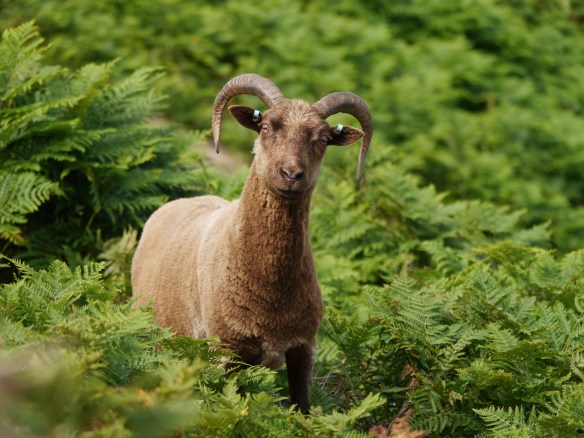By Liz Corry and Jon Rault
They might not seem like it at first glance, but the sheep at Sorel are part of a special task force deployed in Jersey to help protect and serve the Island’s biodiversity. And now to boot they have celebrity status! Having featured on BBC’s Countryfile back in summer and subsequently attracting tourists to the north coast they have once again hit the headlines with ITV Report.
The report by Katie Robinson (ITV Channel) can be found by clicking here or following The National Trust for Jersey‘s Facebook page. There is a nice video as well featuring ranger Neil Harvey and a cameo from the chough flock.
Working hard on our coastline since 2009
Having been established back in 2009 with just 20 breeding ewes and two rams, Jersey’s conservation grazing flock of Manx loaghtan sheep is now almost 200 strong. The Manx loaghtan, a hardy rare breed thought to be the closest living relative of the now extinct Jersey sheep, originate from the Isle of Man. Since their introduction, the flock have been invaluable in addressing the widespread ecological degradation that has taken place along Jersey’s north coast.
Historically, the coastal headlands and slopes on Jersey’s north coast were grazed; however changes in Jersey’s economy during the early 20th century led to the cessation of traditional mixed farming practices on marginal land. When active management ceased, the semi-natural open grassland and heathland habitats characteristic of traditionally farmed marginal areas began to be invaded by bracken and scrub. The invasion of bracken in particular, which now blankets vast swathes of land along the north coast of the Island, has sadly led to a widespread decline in biodiversity.
Reinstating active management is the key to restoring species-rich semi-natural maritime grassland and heathland habitats. The Manx loaghtan flock contribute enormously in this respect. Through the action of trampling, the sheep help to reduce the cover of bracken, while grazing controls the growth of competitive plant species, prevents scrub invasion, and facilitates the development of diverse plant communities with varied sward structures. In addition, patches of bare ground and animal dung resulting from sheep grazing provide important resources for invertebrates.
Sheep, choughs and other birds
The Manx loaghtan grazing area at Le Don Paton provides ideal habitat for the choughs. These iconic birds forage for invertebrate prey in areas of short turf and dung produced by the grazing sheep, and also use wool in nest building. In addition to benefiting Jersey’s resident wildlife, the short grassy areas maintained by grazing also provide feeding opportunities for migratory bird species of conservation concern, such as meadow pipit, wheatear and ring ouzel. 
The increase in the size of the flock is fantastic news as it will allow this highly effective and sustainable management technique to be more widely applied, facilitating the restoration of Jersey’s coastal headland habitat for the benefit of our native wildlife.
Sheep and people
The flock have proven to be extremely popular with both visitors and local residents alike, to the extent that they are now something of a visitor attraction. An additional benefit of the increase in flock size is the increased production of high quality meat for the local market, as well as wool for craft knitting.






